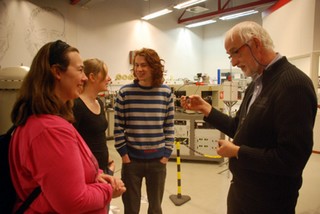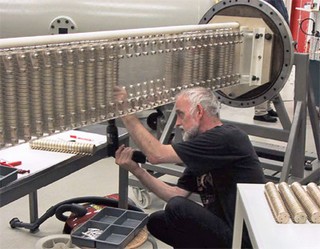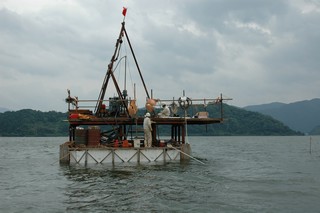A better focus on the past

University of Groningen scientist Hans van der Plicht is one of the authors of a paper published in Science on 19 October. The paper describes a significant improvement in the dating of organic samples using the carbon-14 technique.
The key to understanding the history of humanity is to date events correctly. Take the Neanderthals. These evolutionary cousins of modern humans disappeared some 30,000 years ago. But why? Some have suggested that climate played a role, but to make this plausible climate change (as recorded in, for example, ice cores from Greenland) must be found to coincide with their disappearance.
‘We are getting much better at dating events that can be correlated with ice cores’, explains University of Groningen scientist Hans van der Plicht. ‘But the accuracy for absolutely dating Neanderthal remains still has a large margin of error.’ The carbon-14 (14C) technique (see next page for a fuller explanation) can be used to date bones and charcoal from ancient fires.
This technique is well calibrated for the first 12,000 years or so, but beyond that the margin of error increases. Van der Plicht has dedicated most of his career to refining and calibrating the technique. He does this at the University of Groningen Center for Isotope Research (CIO), one of the leading labs in the world of 14C dating.

14C dating
Plants absorb carbon dioxide from the atmosphere and use the carbon as a building block in photosynthesis. Herbivores eat the plants, carnivores eat the herbivores and eventually all living organisms contain atmospheric carbon. The most common form of carbon is carbon-12, but high in the atmosphere cosmic rays produce small amounts of carbon-14, a heavier isotope that is also radioactive.
14C is treated in more or less the same way as 12C by living organisms. As long as an organism is alive 14C enters its system with the intake of food, but when it dies the intake of carbon stops. The 14C present in the organism starts to decay and has a half-life of 5730 years (meaning that after 5730 years only half of the original amount of 14C is present).
This means that if you know the original amount of 14C in your sample (which equals the atmospheric concentration) you can measure the age of any carbon-containing remains: simply measure the 14C and determine how much has disappeared. The half-life of 14C will then give you the correct age.
The snag is that the concentration of atmospheric 14C can vary due to variations in the intensity of cosmic radiation caused by changes in the earth’s magnetic field (which blocks part of the radiation). As a consequence, the 14C timescale varies and is out of sync with the historical calendar. The solution is to calibrate the method by measuring the 14C content of material with a known age. An archive of tree rings going back more than 12,000 years provides excellent calibration material, but calibration has proved more difficult with older samples.

In 1998, Hans van der Plicht published a paper in Science showing how core samples from the sediment on the bottom of the Lake Suigetsu in Japan might extend the tree-ring archive considerably. The algae in the lake go through an annual cycle of growth and death, which is reflected by a banding pattern in the sediment. These laminations can be counted – much like tree rings – and go back more than 52,000 years. The 14C content in plant samples found in the sedimentary layers can therefore be used to calibrate the 14C dating method.
‘But as it turned out, there were gaps in the record’, Van der Plicht explains. Japan is earthquake prone, and this may have caused underwater landslides. ‘So we had to revert to other archives, like limestone stalagmites in speleothems or coral reefs.’ Both can be dated using other radioactive systems (such as uranium-thorium decay), but these are less accurate than year rings in trees or lakes. Furthermore, these records are not consistent with each other.
Enter a British-Japanese team that returned to the Lake Suigetsu and extracted three additional sediment cores. They combined these three cores with the core used by Van der Plicht. The gaps in any single core could then be identified and corrected using the other three. The original idea of Van der Plicht’s 1998 paper finally paid off.
‘We managed to improve our calibrations considerably. By combining the lake sediments with information from other calibration archives, we now have a margin of error of a few centuries around 30,000 years back, and some 1,500 years at the limit of the 14C method, about 50,000 years ago.’ Beyond about 50,000 years ago, the samples do not contain enough 14C to give an accurate measurement.

The lake sediments have improved the calibration significantly, but the measurements could be even more accurate. ‘The sediment layers are not easily distinguished, and the deeper you go, the less accurate the count is.’ Tree rings are more robust, but in Northern Europe tree-ring archives hardly extend beyond 12,000 years, the time of the last ice age, because trees are unable to grow in such a cold climate.
‘But there is a rather interesting development’, says Van der Plicht. Ancient wood from Kauri trees has been found in swamps in New Zealand. Van der Plicht points to a box in his office. ‘There’s a piece of Kauri wood in there that’s 30,000 years old.’ And what is more, it looks highly likely that a continuous archive of Kauri trees can be assembled, extending perhaps all the way to 50,000 years ago.
‘But the dendrochronology work on these trees – analyzing the patterns of tree rings and assembling a continuous archive – still needs to be done; this will take years. If it is done though, it would give us the best possible calibration for the 14C method.’
The Science paper can be accessed here. A press release on the paper can be found on the University of Groningen website
| Last modified: | 23 December 2016 2.20 p.m. |
More news
-
21 November 2024
Dutch Research Agenda funding for research to improve climate policy
Michele Cucuzzella and Ming Cao are partners in the research programme ‘Behavioural Insights for Climate Policy’
-
13 November 2024
Can we live on our planet without destroying it?
How much land, water, and other resources does our lifestyle require? And how can we adapt this lifestyle to stay within the limits of what the Earth can give?
-
13 November 2024
Emergentie-onderzoek in de kosmologie ontvangt NWA-ORC-subsidie
Emergentie in de kosmologie - Het doel van het onderzoek is oa te begrijpen hoe ruimte, tijd, zwaartekracht en het universum uit bijna niets lijken te ontstaan. Meer informatie hierover in het nieuwsbericht.

